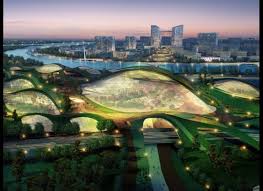
03 May EARTH MATTERS: ASIA GOING GREEN

Eco-city Tianjin in China
As self-serving politicians funded by the fossil fuel industry inhibit progress in America, Asian countries are quickly moving towards reducing risk, building resilience, and creating new economic opportunities by abandoning the business-as-usual approach in favor of going green.
By 2020, China, India, and Japan will be three of the five largest economies in the world and add 110,000 people every day to a regional population that will exceed 4.5 billion. To put this in perspective, there will be more middle-class consumers in Asia than there will be in America and Europe combined. Consequently, Asia will have to run a gauntlet of challenges over the next decade.
Top on Asia’s list of challenges are some of the issues currently plaguing America such as overdevelopment, poverty, healthcare, food security, water shortage, terrorism, inadequate transportation systems, political gridlock, and environmentally hazardous energy production. Particulate matter in America from sources like coal burning power plants kills more people every year than heart disease.
Faced with an existential task to go green or go bust, Asia leaders realize that only by adopting progressive, greener methods will they be able to achieve sustainable economic growth without causing devastating impacts. The key sectors targeted for the green revolution include energy production, transportation, and urban development.
 As of December 2012, China has overtaken Europe in creating the world’s longest high-speed rail network. Stretching 5,800 miles with an average speed of 124 mph or higher, Chinese can now travel from Beijing to Jinan, a distance of about 250 miles, in 1 hour and 32 minutes. In comparison, a ride on the antiquated American rail network takes 2 hours and 45 minutes to travel a slightly shorter distance of 230 miles from Washington D.C. to New York City.
As of December 2012, China has overtaken Europe in creating the world’s longest high-speed rail network. Stretching 5,800 miles with an average speed of 124 mph or higher, Chinese can now travel from Beijing to Jinan, a distance of about 250 miles, in 1 hour and 32 minutes. In comparison, a ride on the antiquated American rail network takes 2 hours and 45 minutes to travel a slightly shorter distance of 230 miles from Washington D.C. to New York City.
True to their progressive vision of a sustainable future, the Chinese have also begun developing an entire eco-friendly city. Spanning 18.7 square miles, the 350,000 resident sustainable community of Tianjin will showcase innovative energy-saving technologies. Highlights of Tianjin will include an advanced light rail system and varied eco-landscapes ranging from a sun-powered solarscape to a greenery-clad earthscape.
Not to be left behind, American manufactures like automotive newcomer Tesla Motors have expanded their market to Asia in order to capitalize on the lucrative economic opportunities generated by sustainable development. Recognizing a potential niche for the mass production of an electric Tuk-tuk to replace the obsolete fossil fuel powered three wheelers that are a common mode of public transportation throughout Asia, the futuristic electric Tesla Tuk-tuk will reduce greenhouse gas emissions and save money. Impressively, Tesla has garnered a high-powered list of investors like the former executives of Apple Japan, Google Japan, Sony, and Compaq.
Hopefully, Americans will take notice of the potential social, economic, and environmental opportunities of going green and vote for politicians that support moving our great country towards a sustainable future.


Billy Mason
Posted at 07:52h, 31 MaySince 2009, renewable energy investment has outpaced coal investment in China. In fact, wind alone outpaced new coal plant investment in China in 2012.